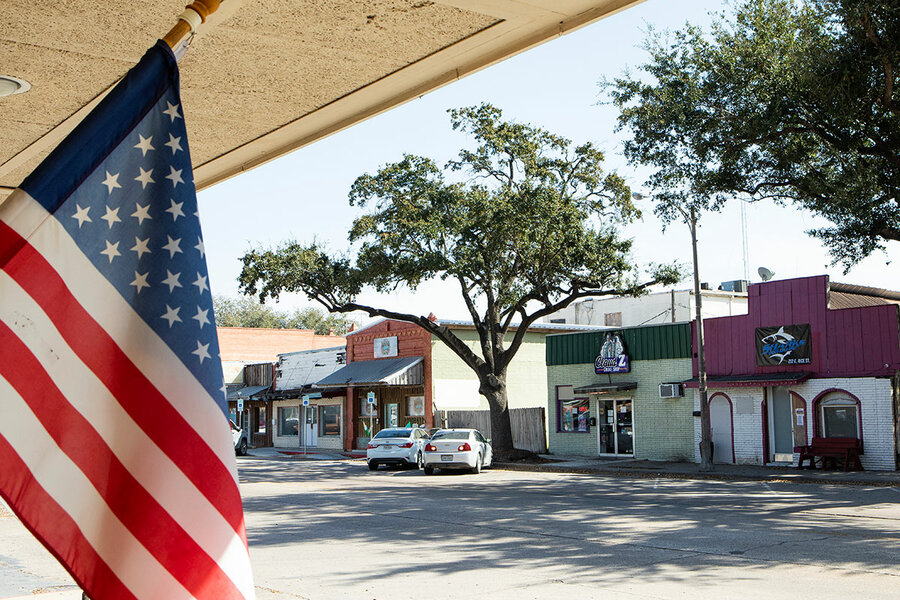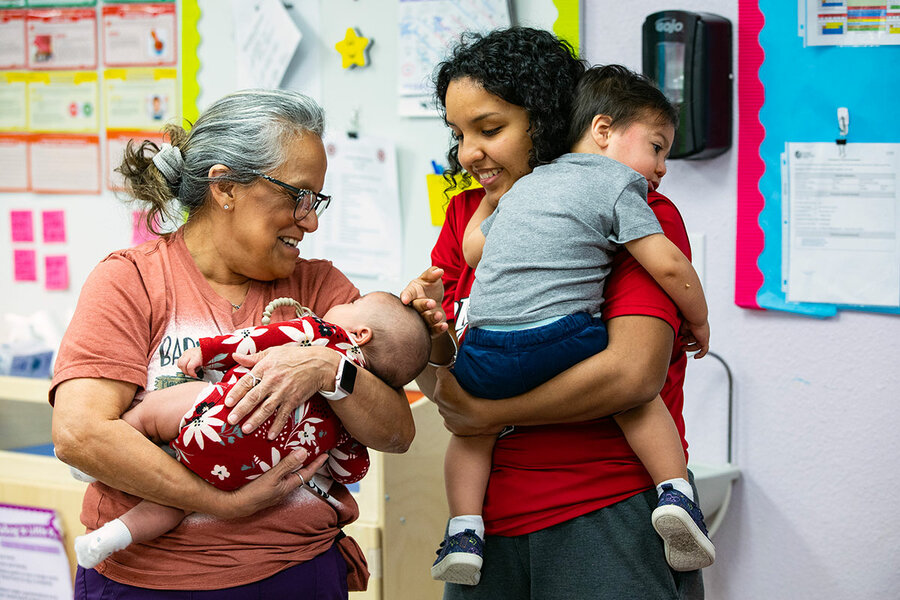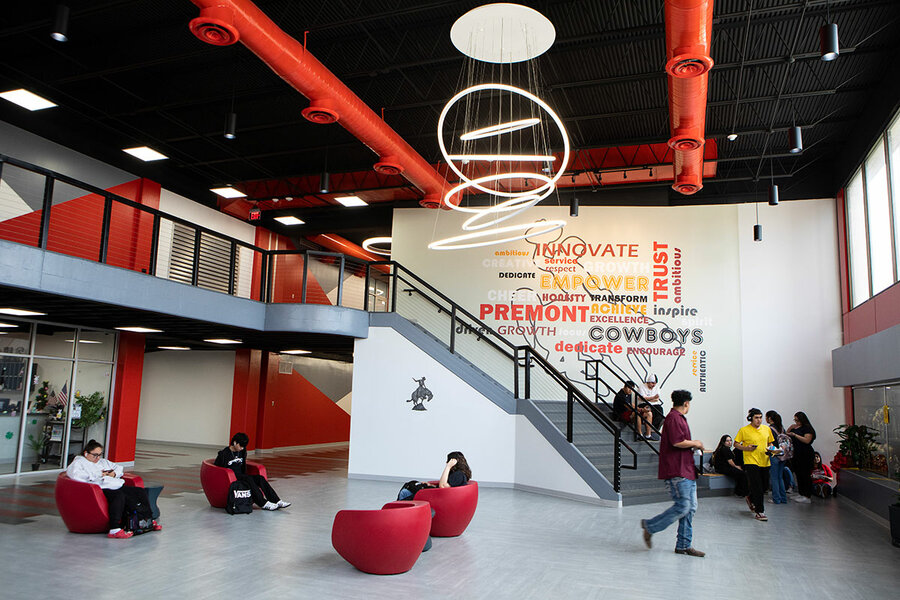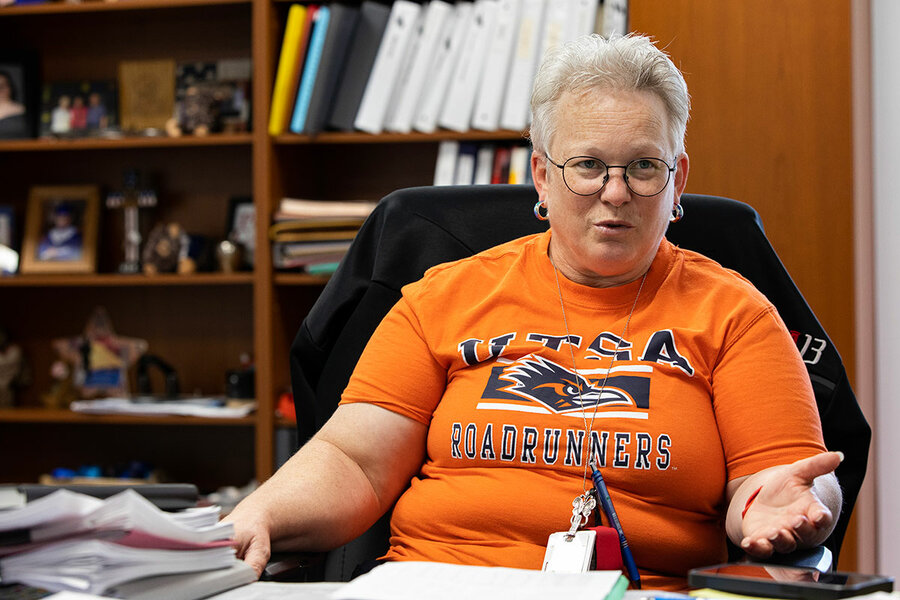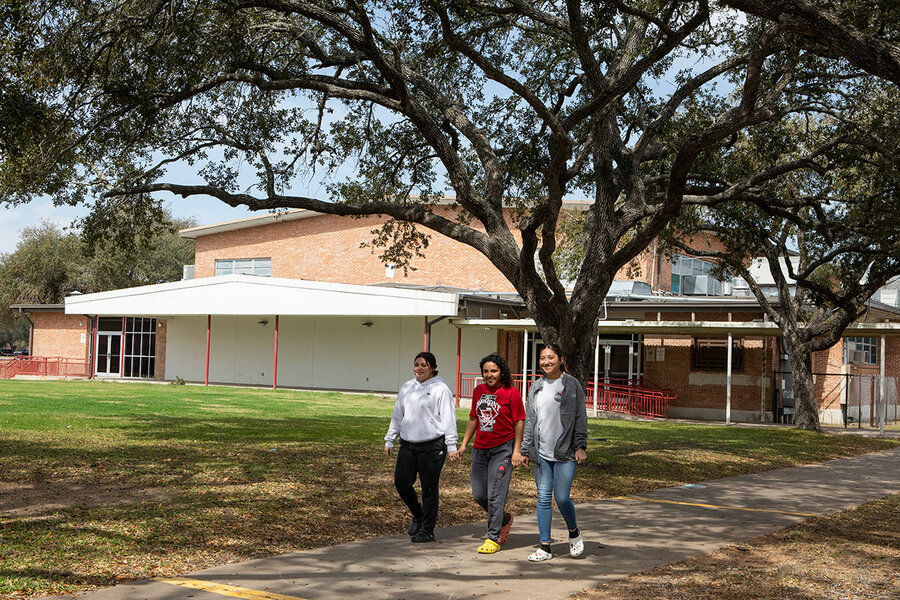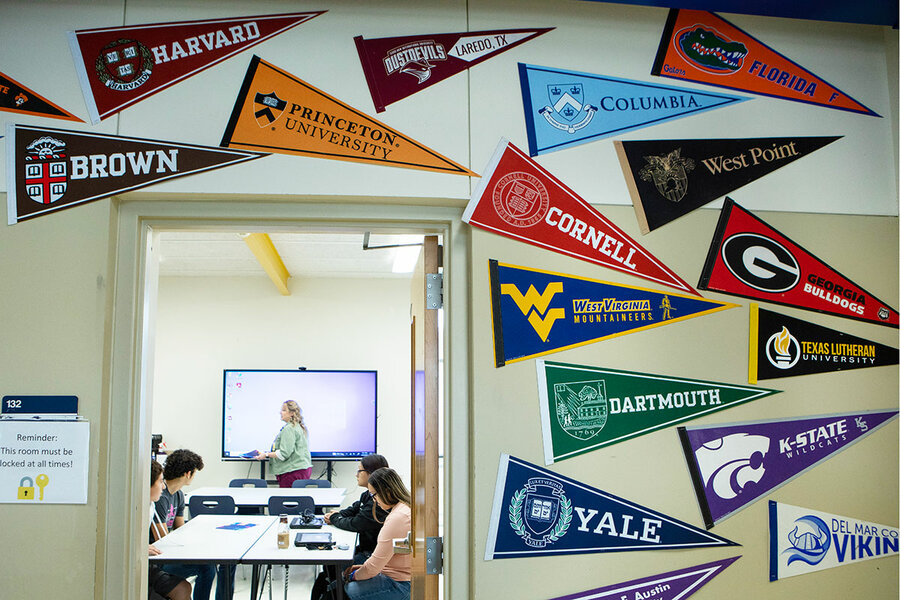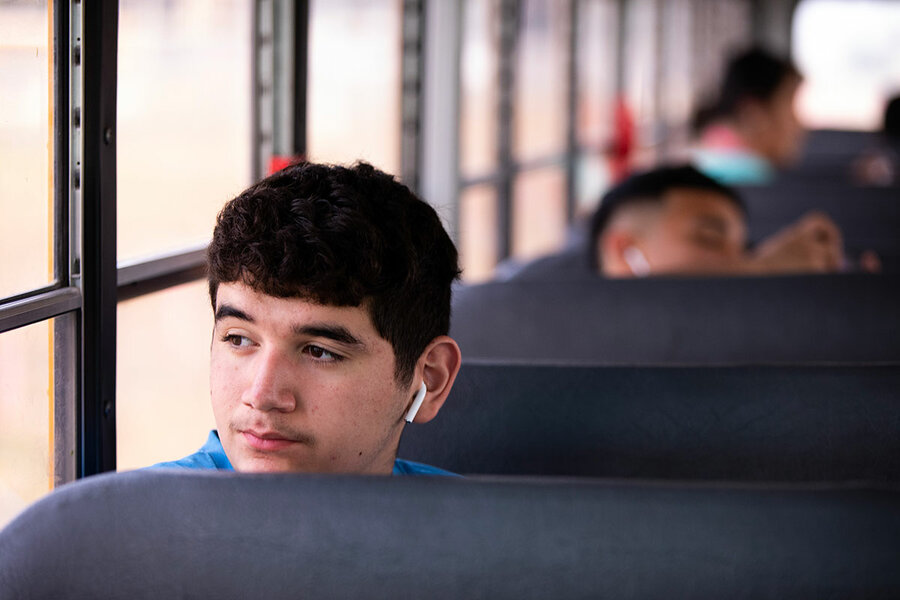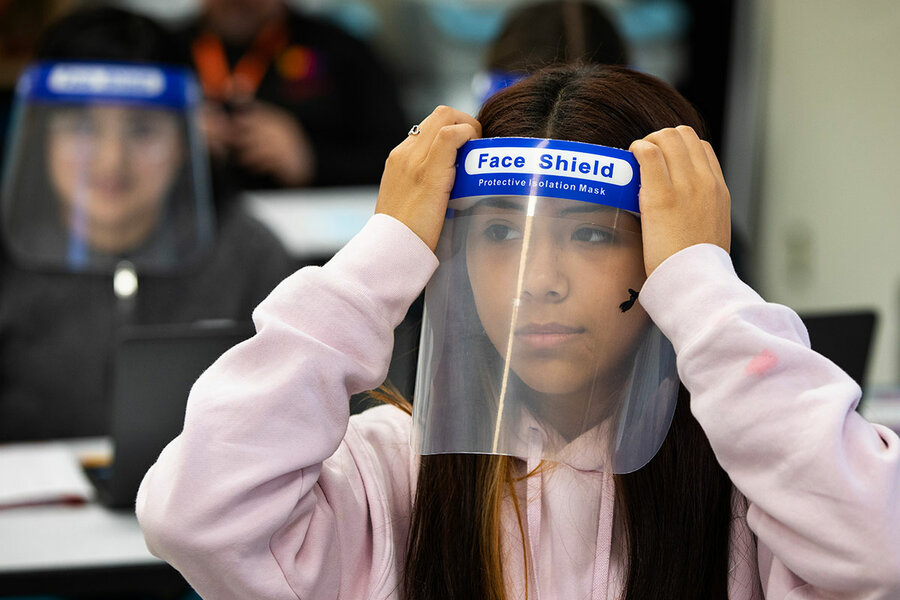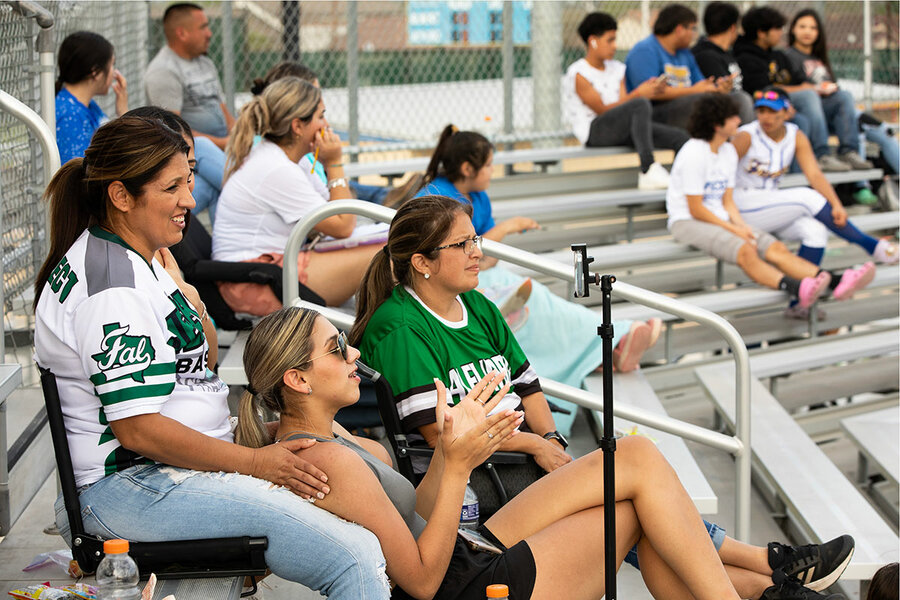When a well-known community member dies in Atlanta, Texas, the funeral is often held in the high school auditorium.
“It’s the only place in town that can hold that many people,” says Atlanta schools Superintendent Jason Harris. “It’s just the heartbeat of the local community.”
Downtown Atlanta – about 10 miles from the border of Louisiana and Arkansas – features a grocery store, a hardware store, a public library, a feed store, and a couple of auto parts stores. There are about a dozen churches.
Why We Wrote This
Rural Texans are deeply conservative – and deeply committed to their public schools. How will that play out in an era when school choice has become a GOP litmus test?
In the rural towns where he’s worked, these social and cultural bonds are as important as any other service the public schools provide. The school and the community are indistinguishable, sharing Friday night football and Sunday morning services, good times and bad times.
“I’ve always been extreme East Texas,” says Mr. Harris, in a thick, piney woods drawl. Like most rural public school teachers, Mr. Harris taught multiple subjects and coached multiple sports. (Science was his area of expertise.) In the past 30-plus years, he’s never worked more than 20 miles from the Louisiana or Arkansas state line.
“Strong Christian, conservative values … the towns I’ve been in, they want their public schools to represent that,” he adds. “There is not a one-size school that fits everybody, but public schools do our best to do that for all kids.”
For decades, this has been the dynamic in Texas: Rural Texans are important to Republican dominance in the state, and public schools are important to rural Texans. This is because in rural Texas, as in rural America, a town is only as healthy as its public schools.
Thus, rural lawmakers are often decisive in determining the state’s education policy. As the country’s education landscape has diversified beyond the traditional public school system toward public, charter, private, and home-school options, efforts in the Lone Star state to keep pace have crashed against a wall of deeply conservative Republicans who are deeply loyal to public schools.
That is, until this year, perhaps. With the anxieties and uncertainties of pandemic schooling still fresh in the memory, with public education dragged into the culture wars maelstrom, and with a record surplus of over $30 billion to play with, Texas conservatives are more optimistic than ever of significantly altering K-12 education in the state.
Most controversially, the state legislature – in session until the end of May – is likely to vote on creating an education savings account (ESA) program. Similar to voucher programs taking hold in other Republican-led states, it would allow eligible parents to use public funds for “educational services” like tutoring, home-school supplies, or private school tuition. Parents of a student would receive $10,000 a year, and the student must have been enrolled in public school the previous year, according to one bill. While school choice has increased in Texas, the state has never allowed public tax money to be used for private education.
The damage such programs inflict on the public school system, and the efficacy of the programs themselves, are hotly debated. There isn’t much academic consensus on those questions, but states like Texas are considering them in a climate of declining public school enrollment, stagnant teacher salaries, and safety and security concerns.
In rural communities, these debates have real-life stakes. Where wages are low and jobs are scarce, a good education is still the surest route to breaking the generational cycle of poverty. Local schools are often not just the social and cultural hub of the community, but the biggest employers as well.
And in rural Texas – which holds half of the state’s public school districts, and the decisive Republican voting bloc in every statewide election since the Clinton administration – these debates are especially complex.
“A lot of our values line up with the Republican Party, but the Republicans are not public school-friendly, so it is a dilemma for us,” says Mr. Harris.
“It’s hard on us to have people in Austin telling us how to run our schools,” he adds. “Public education is not perfect, but I dare to say private education is not perfect either.”
Saving schools – and towns
Superintendent Steve VanMatre started out as a janitor.
After moving to Corpus Christi, he spent nights cleaning an elementary school while he earned college credits during the day. After a few years, he had enough credits to be a substitute teacher. For a few more years he did both, sometimes cleaning at night the school he had taught in earlier that day, as he progressed from teacher to principal and then superintendent.
After a decadeslong career in public education in South Texas, he retired.
Then he unretired to become superintendent of the Freer Independent School District (ISD) in 2014. A state committee had just completed a scathing report about the district’s inefficiency. It had already been consolidated once by the state, and now the threat of consolidation loomed again.
“There are ghost towns all across rural Texas of communities that don’t have school districts anymore,” says Mr. VanMatre. By the time he left three years later, enrollment was stable, teacher retention had improved, and the town had passed a bond to build new facilities. So Mr. VanMatre stepped into an even worse situation 60 miles southeast to become superintendent of Premont ISD.
There was low enrollment, no certified teachers in third and fourth grades, and no varsity football program. The high school building didn’t have heat or hot water. One afternoon in January 2017, pulling lunch duty with Mike Gonzalez, the principal at the time, they could see their breath mist in the air as they talked. The district’s struggles made national news. It received two closure notices from the state in six years.
“It hurt thinking that it wasn’t going to be around anymore,” says Claudette Garcia, a Premont native and graduate, and now principal of Premont Collegiate High School.
In a rural town, the local school is central to the local identity – and it’s something they’re fiercely protective of. Premont saved its school district, and now it has transformed into one of the most attractive, high-performing rural districts in the state.
“If [rural schools] can find a way to provide multiple pathways, early college opportunities, have adequate facilities, they can compete with anybody,” says Mr. VanMatre. “I don’t think a voucher system would hurt.”
But more on that later.
GOP’s new litmus test
The idea for vouchers is often credited to libertarian economist Milton Friedman, who in a 1955 paper argued that government should fund education but allow parents to choose what “educational services” the funds are spent on. Southern states put the proposal into action as a means to maintain de facto segregation toward the end of the Jim Crow era. In 1968, a U.S. Supreme Court ruling struck down state choice programs as racially discriminatory.
In the 2000s, voucher programs gained renewed momentum – now with establishment of religion concerns. In a 2002 case, the U.S. Supreme Court opened the door, saying for the first time that the government could give parents public money to spend at religious schools. The high court in recent years has made it even easier for private religious schools to access public funds. Meanwhile, dissatisfaction with public education has increased, particularly among Black and Hispanic parents.
The pandemic, and its aftermath, brought these concerns to a crescendo. “Parents’ rights” became a cornerstone of Republican campaigns in 2022, and school choice became a political and cultural issue like never before.
“It became not just a fringe issue, but a litmus test issue for the right wing of the [GOP] in ways that it hadn’t been before,” says Douglas Harris, a Tulane University professor and expert on the economics of education.
And in the past few years, voucher programs have exploded. What began in the 2000s as small, targeted programs in a few states to help low-income families or children with special needs is now expanding to include any family in a state.
Florida launched a scholarship program in 2019 providing vouchers for 18,000 students. A year later the state raised the number to more than 46,600 students. This year, state lawmakers are debating a bill that would lift requirements that families be lower-income or have children with special needs, potentially steering as much as $2.4 billion in public funds to private entities.
Arizona last year made its voucher programs – historically targeted to students in low-performing public schools, children with special needs, and children of active service members – open to every student in the state. This January, Iowa’s Republican Gov. Kim Reynolds signed into law an ESA program that will, after three years, be available to every family in the state.
Meanwhile, school choice options have rapidly expanded in Texas. The number of public charter schools in the state increased by 43% between 2014 and 2020 (now only California has more). Home schooling has also increased, including a 40% spike in 2020 and 2021, according to data collected by the Texas Home School Coalition, a nonprofit that promotes home schooling.
As these options have grown, public school enrollment in Texas is declining. Decreased birth rates in the state are also a factor. Competition for funding – which is based on average daily attendance – is fierce. But a program giving some of those public funds to private education entities has always been a nonstarter – until now.
“All in on school choice”
“The governor and I are all in on school choice,” said Lt. Gov. Dan Patrick in his inaugural address in January.
Coming from a prominent school choice supporter, the only surprise in that sentence was the first two words.
Gov. Greg Abbott – a conservative, but calculating, politician – had led Texas for seven years without taking a clear position on vouchers. But in recent months he’s made it clear that he would like to see an ESA program.
“That will give parents the ability to choose the best education option for their child,” he said during a January speech in Corpus Christi, the Texas Tribune reported.
There is a reason Governor Abbott was quiet on this issue for so long. It’s because people like Rep. Ken King have been so loud.
Representative King is from Canadian, Texas – a town of 2,200 in a county of 3,200 in the Texas Panhandle. He has an ‘A’ rating from the National Rifle Association and has been endorsed by the Texas Alliance for Life. Among the bills he has sponsored this year is one that would impose “an additional fee for the registration of electric and hybrid vehicles.”
But he represents 19 mostly rural counties, and he doesn’t support a voucher program.
“If I have anything to say about it, it’s dead on arrival,” he said at a Texas Tribune event. “It’s horrible for rural Texas. It’s horrible for all of Texas.”
Mr. King’s staunch opposition to hurting small-town school funding is very much in line with his fellow rural Texans. Combined with opposition to vouchers from Democrats in the minority, school choice policies have struggled for votes.
Historically, “a lot of [rural Texans] felt like eroding the school, the funding process, was going to be a problem for their community, so they rejected it,” says Brandon Rottinghaus, a political scientist at the University of Houston.
But GOP officials around the country have ramped up criticism of public schools in the past two years – inspired by pandemic frustrations and concerns over how subjects like race, gender, and sexuality are taught.
“It’s [been] an electoral winner,” says Professor Rottinghaus, even though it might not be voters’ top issue. Given those national trends, he adds, “it’s a logical time – maybe the best time – for school choice proponents to act.”
Do voucher programs work?
The most common criticism of ESA programs is that they drain money from the public school system, making it harder for public schools to compete. In the long run, they could create a two-tiered education system that disadvantages families who want to – or have to – keep their children in public schools. Critics also argue that the primary beneficiaries of vouchers tend to be families who already can afford private school.
“Seventy-five percent of vouchers are going to end up going to kids who are already in private school,” says Superintendent Harris. “That 75% [are] public funds taken from us.”
School choice already exists in the area, he notes. There’s a charter school and four private schools in Texarkana, 25 miles away. Redirecting more public funds to a voucher program would make it even harder for rural schools to attract students.
“I just don’t see how vouchers would not harm public schools,” he says.
Then there is a question of whether switching to private schools improves outcomes for those students.
“Some studies have shown positive student outcomes, and some have shown negative student outcomes,” says Ben Erwin, senior policy analyst at the nonpartisan Education Commission of the States. “I wouldn’t say there’s a consensus in the field.”
“Advocates on both sides of this debate would argue potential benefits,” he adds.
But promoters of school choice say widespread damage to public schools hasn’t materialized in states with long-standing voucher programs.
In the past decade, Arizona public schools have improved from near bottom to above the national average in reading and math, per the National Assessment of Educational Progress. For two decades, Florida public schools have stayed at or above the national average for reading and math.
“You’re not seeing mass layoffs, mass school closures. What you’re seeing is schools organically, over time, responding to parent needs and improving their performance,” says Jason Bedrick, research fellow at the Center for Education Policy at the conservative Heritage Foundation.
Of course, the voucher programs in Arizona and Florida were both much smaller until this year.
Research has shown that students who opt into statewide voucher programs don’t improve. Ohio, Louisiana, Indiana, and Florida all have statewide programs “similar to the kinds of programs that are being designed and implemented now around the country,” says Dr. Harris at Tulane University.
Studies of the four programs found that, in all but Florida, “students who use vouchers learn less … than they would have had they just gone to public schools,” he adds.
Other studies have reached different conclusions. An analysis of the literature by EdChoice, a nonprofit advocating for expanding school choice, concludes that these programs have had mostly positive effects.
Voucher supporters also note that states choose the degree to which they fund the program, and can strike a balance between public and nonpublic funding. In Texas, with its history of rural support for public schools, a compromise will likely be necessary.
“There are ways to satisfy all stakeholders here … especially for the neediest students,” says Alexander Salter, an associate professor of economics at Texas Tech University. “School choice is a complement to, not a substitute for, the traditional public school system.”
Will the money come with expectations?
In Cushing, a rural town 100 miles due south of Atlanta, Brandon Enos thinks “competition makes us all better.” But he has one important caveat.
“If you add the accountability, I’m all for it,” says Dr. Enos, the Cushing ISD superintendent. “Money collected from taxpayers shouldn’t be given to private entities where there’s no accountability.”
Private educators generally aren’t subject to the same standards that public schools are – and the current bill doesn’t require them to release test results or account for how they spent taxpayers’ money, according to the Texas Tribune. Private schools and home-schools can pick and choose their students, enjoy less oversight in terms of curriculum and student progress, and discriminate against current or prospective students in ways that public schools can’t.
Parent Kathy Covey has the same concern – but from a different angle.
While Superintendent Harris has been working in East Texas public schools for the past 30 years, Ms. Covey has been home-schooling her eight children in Mauriceville.
“We’ve had to finance ourselves, and it can be difficult,” she says.
She would be interested in an ESA, but with one big question.
“When the government starts handing out money, … we’re accountable then to them,” she says. “How much then would [the state] feel like they have a right to intervene?”
If Texas does create an ESA, Hope Owens doesn’t intend to make use of it.
Ms. Owens is president of the Texarkana Organization of Resolute Christian Homeschoolers (TORCH). She and her two children are part of the network of about two dozen local families who home-school. She’s “pretty content” with the size.
“I guess I’m a person who likes the government staying out of my business as much as possible,” she says.
Her husband is a robotics teacher at a public junior high school.
“I felt both options were there, but it came down to giving [them] a personal and a Christian education,” she adds. “I do feel like we’re able to shelter our kids more.”
If the Texas legislature does pursue an ESA program, specifics around accountability measures and the division of state funding will have to be worked out.
In Idaho last month, the Republican-dominated state legislature voted down an ESA law largely because those kinds of specifics weren’t clarified. It’s a sign that, even in solidly conservative states, voucher programs aren’t a slam dunk.
The proposed ESA program “could have serious negative consequences for many Texas school districts, especially those in rural areas,” writes state Sen. Judith Zaffirini, a Democrat whose district includes Freer and Premont ISDs, in an email.
The loss of per-student funding for every child who opts out of their local public school “could have a ripple effect, potentially leading to decreased funding for rural districts,” she adds. “Because rural schools already face funding disparities compared to their urban counterparts, this program could exacerbate these inequities.”
Voucher advocates claim that, because rural areas tend to have few options besides the local public school, those areas wouldn’t experience much change. Mr. Bedrick at the Heritage Foundation argues that it could keep families in small towns.
“Without school choice, their options are keep their child in that school knowing their child isn’t getting the best education they can get, or move,” he says.
“This can really help families stay in the communities they know and love.”
In The Zone
In South Texas, members of the Rural Schools Innovation Zone (RSIZ) believe they’re showing how rural public schools can give students the best education possible.
The first thing to note is that the buses have Wi-Fi.
The Zone is a way for smaller districts to team up and provide the services of a large district. But this creates challenges, like travel. When there are only so many hours in the day, and two of those are spent driving between campuses, that time is needed to study.
On this Thursday morning in late February, most of the 17 Premont students are chatting, napping, or listening to headphones as they drive south on a two-lane highway, hundreds of miles of ranchland sprawling around them.
Fifteen minutes later, the students step off a bus at Falfurrias High School. It’s time for welding class.
The Ignite Technical Institute – which trains students in welding, construction, and electrical systems – is one of five “academies” offered as part of the Zone by the three participating districts. Falfurrias also hosts the Junior ROTC program; Premont hosts the STEM and education training programs; and Freer hosts the medical training academy. The programs all enable the students to earn college credits or trade certifications, for free.
“The whole premise behind the Zone is that just because you go to a small school, or you live in a small town, you shouldn’t have your options limited,” says Ms. Garcia, the Premont high school principal.
It has taken a couple of years for the Zone to establish itself, but results are visible. For one, students are succeeding in the academies more than they used to.
Freer used to have a welding program and a nursing certification program. Neither was doing very well, says Conrad Cantu, the Freer ISD superintendent, not least because they couldn’t be a high priority for the small, resource-strapped district.
“We couldn’t even get kids to test [for nursing]. It was just kind of on the side,” he adds. “With 200 kids, it’s hard. We’re just trying to have school.”
By joining the Zone, Freer was able to send its students to Ignite at Falfurrias and cut its own welding program – which then allowed it to improve and expand the medical program. There are now three dedicated classrooms for the Next Generation Medical Academy, with some equipment that nearby hospitals don’t even have.
And the three participating districts have seen student outcomes improve, particularly in terms of college, career, and military readiness.
Some Premont seniors, for example, spend part of their Thursdays at the school’s Grow Your Own Educator Academy. The next afternoon, they’re an hour away in Freer, at the Next Generation Medical Academy, practicing how to insert an IV.
“There is no way any one of those school districts could have supported five academies unilaterally,” adds Mr. VanMatre, the former Premont superintendent.
“You’re keeping [schools’] identities, you’re managing resources better, and you’re opening up opportunities for kids.”
But the Zone is still facing challenges – including an uncertain future.
Four years in, “not everyone is on board with the Zone,” says Mr. Gonzalez, the RSIZ executive director and former Premont high school principal. There have been arguments over scheduling, funding, discipline, even dress code. (Boys are allowed to wear earrings at Premont, but not at Falfurrias; Falfurrias athletes play games during the day, but Premont and Freer athletes don’t.) Fortunately, there haven’t been any fights.
The Zone needs a certain number of students to be viable. Premont and Freer have committed to at least two more years, but Falfurrias has been on one-year contracts. At the end of this school year, it will decide if it wants to stay involved. If it leaves, the programs might become too great a financial burden for Premont and Freer to bear.
At a baseball tournament hosted by Freer, in the bleachers, Isabel Perez strikes a note of jealousy and gratitude. Her son, a junior on the Falfurrias baseball team, has been learning welding and electrical systems in the Ignite program.
“It’s awesome,” she says. “I wish they would’ve had it back in my time.”
He does welding and electrical work at home, which they’re remodeling, and at their ranch, she adds. But he doesn’t do it for free. (“Don’t work for free” is a soft skill all the academies teach.)
Ms. Perez doesn’t mind.
“It’s a great opportunity for all the kids to … be independent and get their education early,” she says. “And it helps the parents, regardless of if the parents have the money.”
Ironically, Premont and Freer have been sports rivals for generations. Now they take classes together. The JROTC students even perform the color guard, together, before their schools play each other.
“The night we played in Freer [in football], the color guard was there, and it was kids from all three districts in the color guard,” says Principal Garcia.
“Our teams were fixing to get on the field and battle it out, but right before that, they were carrying the flag together,” she adds. “It’s really powerful.”


